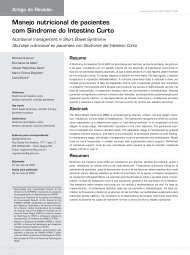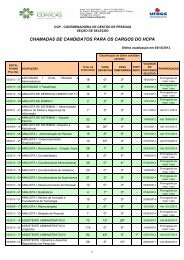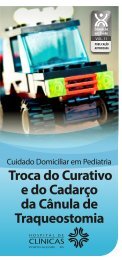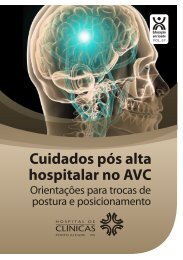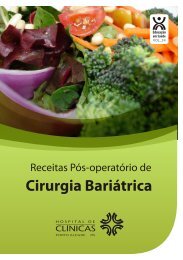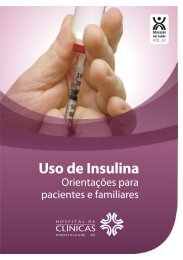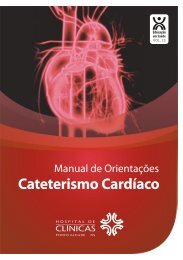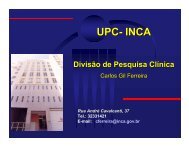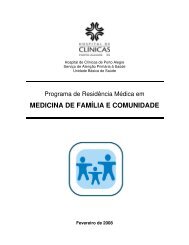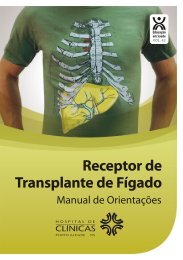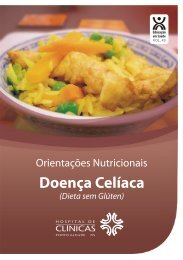Anais da 27º Semana CientÃfica - Hospital de ClÃnicas de Porto Alegre
Anais da 27º Semana CientÃfica - Hospital de ClÃnicas de Porto Alegre
Anais da 27º Semana CientÃfica - Hospital de ClÃnicas de Porto Alegre
Create successful ePaper yourself
Turn your PDF publications into a flip-book with our unique Google optimized e-Paper software.
190<br />
Revista HCPA 2007; 27 (Supl.1)<br />
FEVER INDUCED BY NITROFURANTOIN AS PROPHYLAXIS OF URINARY TRACT INFECTION- CASE REPORT<br />
TIAGO FALCÃO CUNHA; HAYSLAN BOEMER; MARISTELA BOHLKE; FRANKLIN CORREA BARCELLOS;<br />
ADRIANA BAPTISTA MENEZES; PAULO EDUARDO CARUSO<br />
Introduction: Nitrofurantoin is an antibiotic frequently used in the treatment and prophylaxis of urinary tract infection (UTI).<br />
Common adverse reactions are: nausea (8%), hea<strong>da</strong>che (6%), flatulence (1,5%) and, rarely (After 24hr, the patient returned to the<br />
hospital complaining about fever, chills and drowsiness. She was in good general condition, no fever and normal physical<br />
examination; she stayed at the hospital to have her <strong>da</strong>ily temperature evaluated. In her first two <strong>da</strong>ys at the hospital she had no<br />
fever and she wasn’t using nitrofurantoin. On the 3rd night, she had fever of 38.5, chills, hea<strong>da</strong>che and again, urinalysis,<br />
hemoculture and chest x-ray, were done; the exams showed no alteration. By reviewing the case, it was noticed that the patient<br />
had taken nitrofurantoin without medical prescription. The overall diagnosis was fever originated by drug. The drug was<br />
suspen<strong>de</strong>d and the patient was discharged without any symptoms. Conclusion: antibiotic and antipyretics are frequently<br />
recommen<strong>de</strong>d for fever disease. However, they are the most important drugs that cause drug-induced fever and they can be<br />
misinterpreted as treatment failure.<br />
PREVALENCE OF HIGH BLOOD PRESSURE AND ITS RELATION TO ANTHROPOMETRICS INDICES IN CHILDREN<br />
PRESENTING TO A BRAZILIAN EMERGENCY ROOM<br />
TIAGO FALCÃO CUNHA; MARISTELA BOHLKE; HAYSLAN BOEMER; FERNANDA DULLIUS; JULIANA MENEZES;<br />
ADRIANA BAPTISTA MENEZES; PAULO EDUARDO CARUSO.<br />
Introduction: The occurrence of high blood pressure (BP) in children has increased in association with increasing prevalence of<br />
obesity in childhood. The aim of this study is to evaluate the prevalence of high BP and obesity and the relation among these<br />
variables in a group of children who go to the pediatric emergency room (ER) in the municipality of Pelotas, Brazil. Methods:<br />
Cross-sectional study with evaluation of BP, weight, height and body mass in<strong>de</strong>x (BMI) calculation in children between 3 and 12<br />
years old selected in one pediatric ER. Children with systolic and or diastolic blood pressure levels greater than or equal to the<br />
90th percentile were evaluated again in 15 <strong>da</strong>ys, and if the level remained high, these children would be reevaluated on a third<br />
visit with complete clinical and complementary exams. Pre-hypertension was consi<strong>de</strong>red when mean BP levels were between 90-<br />
95 percentiles on three consecutive evaluations and hypertension was <strong>de</strong>fined as BP levels greater than or equal to the 95th<br />
percentile in the three consecutives visits, according to “The fourth Report on the diagnosis, evaluation and treatment of high<br />
blood pressure in children and adolescents”. Results: A total of 365 children were evaluated, 57,8% male, 81,4% white, mean age<br />
of 6,7 years old, 17,3% overweight and 19,2% obese. The percentage of children with BP levels between 90-95 percentiles was<br />
1,6%, 0,3% and 0,3% in the first, second and third consultations respectively. In the same or<strong>de</strong>r, 26,3%, 6,3% and 3,3% of<br />
children had BP greater than or equal to the 95th percentile. Children with BP levels greater than or equal to the 95th percentile on<br />
the mean of the three evaluations had their BMI higher when compared to the ones who had BP levels lower than 95th percentile<br />
(pIn a group of 365 children submitted to an ambulatory treatment, 12 (3,3%) maintained their BP level greater than or equal to<br />
the 95th percentile after the third evaluation. One child maintained the percentile between 90-95 (pre-hypertension). In this<br />
sample of children, overweight and obesity were directly related to high blood pressure.<br />
Cirurgia Proctológica<br />
EFICÁCIA DO ANTAGONISTA DO PEPTÍDEO LIBERADOR DE GASTRINA (RC-3095) NO TRATAMENTO DA COLITE<br />
INDUZIDA POR ÁCIDO ACÉTICO EM RATOS<br />
RENATA HECK; FREDERICO SEDREZ DOS SANTOS; DANIEL DE CARVALHO DAMIN; MÁRIO A. ROSITO; RAFAEL<br />
ROESLER; GILBERTO SCHWARTSMANN<br />
Introdução: A retocolite ulcerativa (RCU) é uma doença inflamatória crônica do intestino grosso. Acredita-se que tenha causa<br />
multifatorial, resultando <strong>da</strong> ativação crônica <strong>da</strong> cascata imunoinflamatória em indivíduos geneticamente predispostos. O<br />
antagonista do receptor do peptí<strong>de</strong>o liberador <strong>de</strong> gastrina/bombesina (RC-3095) é um fármaco <strong>de</strong>senvolvido recentemente com<br />
proprie<strong>da</strong><strong>de</strong>s imunoreguladoras e anti-inflamatórias. Objetivo: Avaliar a eficácia do RC-3095 no tratamento <strong>da</strong> RCU, através <strong>da</strong><br />
utilização <strong>de</strong> um mo<strong>de</strong>lo experimental <strong>de</strong> colite induzi<strong>da</strong> em ratos. Material e métodos: A indução <strong>da</strong> colite é realiza<strong>da</strong> com<br />
enema <strong>de</strong> ácido acético a 5%. Serão 60 ratos Wistar machos com 9 semanas <strong>de</strong> i<strong>da</strong><strong>de</strong>. Os animais serão randomizados para os<br />
seguintes 4 grupos: tratamento com RC (subcutâneo), Mesalazina enema (tratamento padrão 1), corticói<strong>de</strong> subcutâneo (tratamento<br />
padrão 2) e grupo controle. Os animais serão tratatos 24 e 48 horas após a indução <strong>da</strong> colite e sacrificados 24 horas após o último<br />
dia <strong>de</strong> tratamento. Haverá uma avaliação macroscópica e microscópica dos cólons bem como dosagem <strong>de</strong> marcadores<br />
inflamatórios no plasma. Resultados: até o momento foram estu<strong>da</strong>dos 20 ratos. Utilizando-se uma escala <strong>de</strong> intensi<strong>da</strong><strong>de</strong> <strong>da</strong> colite<br />
produzi<strong>da</strong>, com variação <strong>de</strong> entre 0 (ausência <strong>de</strong> colite) e 3 (colite grave com necrose <strong>da</strong> pare<strong>de</strong> colônica) <strong>de</strong>tectou-se a seguinte<br />
variação entre os grupos: grupo colite sem tratamento = 3; grupo colite com tratamento RC = 1; grupo colite com mesalazina = 2;<br />
grupo colite e corticói<strong>de</strong> = 1. Os resultados <strong>da</strong> análise microscópica e laboratorial do sangue ain<strong>da</strong> não estão disponíveis.<br />
Conclusões: Nossos resultados preliminares apontam para a eficácia do RC-3095 no controle <strong>da</strong> colite induzi<strong>da</strong> por ácido acético.<br />
A <strong>de</strong>finição do potencial <strong>da</strong> droga para utilização em mo<strong>de</strong>los experimentais <strong>de</strong> colite e, eventualmente, no controle clínico <strong>de</strong><br />
pacientes com retocolite ulcerativa <strong>de</strong>pen<strong>de</strong>rá, primordialmente, <strong>da</strong> confirmação <strong>de</strong> nossos resultados iniciais.




